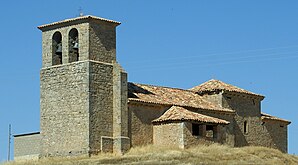Coscurita
| Coscurita municipality | ||
|---|---|---|
 Coscurita - Bordejé Church
|
||
| coat of arms | Map of Spain | |
 Help on coat of arms |
|
|
| Basic data | ||
| Autonomous Community : |
|
|
| Province : | Soria | |
| Comarca : | Comarca de Almazán | |
| Coordinates | 41 ° 26 ′ N , 2 ° 29 ′ W | |
| Height : | 964 msnm | |
| Area : | 54.96 km² | |
| Residents : | 79 (Jan. 1, 2019) | |
| Population density : | 1.44 inhabitants / km² | |
| Postal code : | 42216, 42217, 42223 | |
| Municipality number ( INE ): | 42068 | |
Coscurita refers to a place and a municipality ( municipio ) with 79 inhabitants (as of January 1, 2019) in the south of the province of Soria in the autonomous community of Castile-León . The hamlets of Bordejé, Centenera del Campo, Neguillas and Villalba also belong to the municipality . The Catholic parish belongs to the Diocese of Osma-Soria .
location
The place Coscurita is located in the plateau interspersed with rocks and hills in the south of the province of Soria at an altitude of approx. 960 meters above sea level. d. M. The distance to the northern provincial capital Soria is approx. 43 kilometers (driving distance). The small but historically significant town of Almazán is only about nine kilometers to the northwest.
Population development
| year | 1960 | 1970 | 1981 | 1991 | 2001 | 2010 |
| Residents | 636 | 389 | 214 | 166 | 141 | 112 |
In the first half of the 20th century the community consistently had between 600 and 770 inhabitants. The increasing mechanization of agriculture and the resulting loss of jobs have contributed to a large extent to the significant decline in the population in recent decades.
economy
For centuries the community lived exclusively from growing grain ( barley and wheat ), which was mainly operated for self-sufficiency ; livestock farming ( sheep , goats , chickens ) also took place to a small extent. The place Barca served as a mercantile, handicraft and cultural center for the hamlets and farmsteads in its area, which have now mostly disappeared. Today agriculture still plays the most important role, but there is also marginal income from tourism (rental of holiday homes).
history
After the Arab-Moorish conquest , large areas in the north of the Iberian Peninsula were depopulated . In the 10th century began under the Castilian Count Gonzalo Téllez in the second half of the 11th century under Alfonso VI. Complete reconquest ( reconquista ) of Old Castile , which culminated in the capture of the city of Toledo, about 250 kilometers further south-west, in 1085. During this time Barca was repopulated or repopulated ( repoblación ) by settlers from the Christian north .
Attractions
- Coscurita
The parish church ( Iglesia de San Cristóbal ) is a single-nave building from the 16th century with a bell gable that was renewed in the Baroque period . During a restoration project in 1914, the entrance was moved from the south side to the west side.
- Bordejé
The single-nave parish church of San Martín von Bordejé, built entirely from quarry stones ( mampostería ) - with the exception of the corner stones - is a fine example of rural sacral architecture that does not reveal any stylistic features. While the low windowless nave , the slightly raised crossing area and the just closing apse from the 13th / 14th centuries The sturdy west tower with its deep bell gable can be assigned to the 19th century. The entrance to the church is - as usual in the region - on the south side and is protected from the rigors of the weather by a porch. The overall stocky-looking building manages without lateral supports for the outer walls ( buttresses ). In the vestibule, a disc-shaped grave stele with a small base is walled up - in the north of the Iberian Peninsula actually only to be found in the Basque Country .
- Neguillas
The remains of a watchtower ( atalaya ), which are about two meters high, are located on a rocky hill , but due to its comparatively precisely worked stone material it must be assigned to the medieval-Christian period.
Web links
- Bordejé photos
- Bordejé, grave stele - photo + information (Spanish)
- Neguillas, watchtower - photo + info (Spanish)
Individual evidence
- ↑ Cifras oficiales de población resultantes de la revisión del Padrón municipal a 1 de enero . Population statistics from the Instituto Nacional de Estadística (population update).
